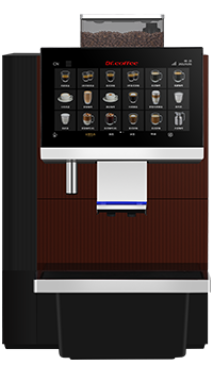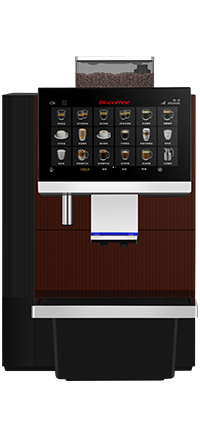

Cold and Hot Milk Coffee Premium Office Experience
The F16 stands as a fully automatic coffee machine tailored for office environments, with a comprehensive upgrade to its milk system, heating mechanism, and grinding components. It ensures improved cup quality and accelerated brewing efficiency. Stable, efficient, and time-efficient, the F16 supports easy bean replacement and one-touch preparation of both cold and hot beverages, catering to the demand for top-notch coffee in professional settings.
Color
Large capacitive display. Prepares a drink with one touch of a button. Supports multiple languages.
The grinding components of this model have been fully upgraded, which reduces wear, extends service life and allows for a stable grinding coefficient to ensure quality in coffee production.
Efficient dispensing – coffee and milk flow out simultaneously, saving half the time needed to prepare drinks.
With a user-friendly touch interface, users can flexibly adjust milk temperature parameters, providing greater freedom in temperature control. When preparing milk-based beverages such as lattes or frothed drinks, users can choose from a wider range of milk temperatures according to their preferences.
The brewing and frothing system automatically cleans itself every time the machine is turned on or off. You can customize your own cleaning schedule based on the number of cups or operating time, making maintenance easier than ever.
Thanks to the dual heating system, the electric hotplate supplies hot water for making coffee, while the boiler creates steam to heat the milk. Simultaneous preparation of the beverage reduces waiting time for the user. In addition, the boiler requires less frequent descaling, which significantly reduces maintenance costs and time.
Fresh grounds fall straight into brewer for extraction. Minimized oxidation, no remains. Each serve is as fresh as it can be
Thanks to the high-performance motor, it provides strong power and can extract milk quickly and stably in a short time, greatly reducing the waiting time for making milk coffees and allowing you to quickly enjoy a delicious drink.
Touch and click to customized your own ground amount, pre-brewing time and temperature. Save the configuration for your favorite coffee reciepe.
The large brewer is desinged to contain up to 16g of grounds with more consistant extraction to guarantee original flavors
Capacity
Recommended daily output
Hourly output
100
70
Technical sheet
Water tank (L)
Bean hopper capacity (g)
Bundle mix hopper capacity (L)
Ground coffee container (g)
Display orientation
Display size
Nominal voltage (V)
Nominal frequency (Hz)
Nominal power (W)
Machine weight (kg)
Dimensions l*w*h (cm)
8
1000
NE
700
Vertikální
10.1″
220-240
50
1500
19.5
34*50*58
Feature
Powder container
Steam wand
Hot water dispenser
Capacitive touch screen
One-touch milk
Milk for coffee at the same time
Self-priming bottled water
Tap water supply
Mobile payment
Automatic milk system cleaning
NO
NO
YES
YES
YES
YES
YES
YES
YES
YES (with external module)
YES

The configurations in your new machine is based on popular preferences generated by big data. If you prefer your coffee differently, you may adjust the configurations.
Electric cable, user manual, water supply pipe, wrench, plastic buffers. Accessories may vary depending on the model. We recommend that you keep all accessories.
Fill up the water tank or connect your water supply, fill up the bean hopper, and turn on the machine. Once the machine is on, calibrate the grind before proceeding with tasks.
We recommend leaving an extra 20cm in height, depth and width on top of the machine size.
Over time, the pipeline of the machine could be blocked with scale buildup. If you have hard water, remember to descale often. Contact customer service or a sales professional for more details.
For each water supply type (bottle/tap/tank) Dr. Coffee has a corresponding solution. Contact customer service or a sales professional for model and solution details.
The best milk temperature is between 2 to 6 degrees. It is reccomended that you use your coffee machine with a matching mini fridge to keep the milk temeprature right.
Re-calibrate your grind if:
1. you change to different beans; or
2. the components are worn over time, in which case the amount of grounds may be inconsistent.
A cup of coffee takes a relatively fixed amount of coffee grounds. But the amount of grounds per grind can be different, depending on the type of beans.
By calibrating the grind, your coffee machine comes out with the precise amount of grounds needed, making sure that each cup is served with consistent quality.
The service password for all Dr. Coffee machines is “1609”
Our machines work perfectly with utility power, 220V, 10A/16A depending on power. Contact customer service or a sales professional for model details.
Water supplied to coffee makers should be of as low hardness as possible. Dr. Coffee recommends purified water with TDS value no higher than 80ppm for all our models.
Some professional Dr. Coffee coffee machines have the ability to connect to an IoT system, which enables a comprehensive solution including mobile payments, remote control and traffic management. Contact customer service or your dealer for more information.
You can rename your beverages and define preparation procedures.
It is recommennded that you do so to save energy and prolong machine’s life cycle.
After changing your beans, please re-calibrate the ground amount.
After changing your milk to one with different fat content, it is recommended that you modify the froth amount in “beverage configuration”.
The larger the number is, the more grounds you get with each grind.
For different scenarios, Dr. Coffee develops models with corresponding “daily productivity” and “efficiency”. Contact customer service or a sales professional for more details.
Yellow interface suggests maintenance. If you see a red interface, please contact customer service for problem-shooting.
Select “cold drink” on the menu, and your machine will prepare a room temperature drink. Add ice cubes into the drink and you get your iced beverage.
If the machine operates properly and you wish to modify the output volume, go to “beverage setting” and select the right volume for you cup.
If your machine is turned off for a while and on again, we recommend that you make a latte and dispose of it, based on the consideration that the machine is not fully warmed up hence the taste may not be ideal.
After the machine prepares your coffee, you may add syrup or creamer into the drink.
If you have special demands, please contact customer service; otherwise it is recommended that you keep the original configurations.
The taste of your coffee has to do with the following factors: ground particle size (5 options available), amount of grounds (5 options available) and pre-infusion time (1 to 5 seconds).
Yes. The reccomended froth temperature is 60 degrees, but you can adjust by turning the “frother knob”. Contact customer service or a sales professional for more details.
We recommend 2 to 6 degrees full cream milk, medium/deep roasted beans instead of light/dark roasted beans.
This is perfectly normal because the machine is set to clean its own pipelines everytime the machine is on/off. Water comes out from the outlet when the cleanse is over.
Dr. Coffee CVS series are designed to make 500,000 cups. Other models are designed to make more than 50,000 cups.
The reasons your machine doesn’t get milk pumped in could vary.
Try unwinding the froth knob a little, and deep cleanse the milk system. If this doesn’t work, please contact customer service or a sales professional.
Contact the distributor if you ordered your machine from one. If your machine is ordered from Dr. Coffee’s website, call the 400 hotline.
Before turning off the machine after your business hours, please deep cleanse your milk system to avoild blockage of pipeline.
It is recommended that you follow the schedule:
Milk system deep cleanse: once a day
Brewing system deep cleanse: once a week
Scale buildup cleansing: once a month
Yes. Water alone doesn’t get rid of all the stubborn coffee grease and milk deposits.